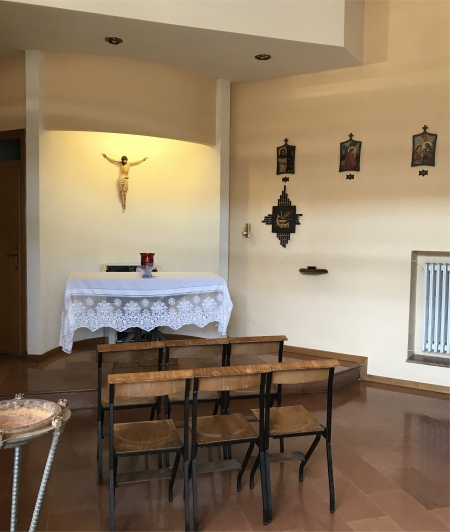 Platform Chapel at Foligno Station |
We said our farewells to the remaining stragglers, and Tony drove us through the stunning Umbrian countryside to Foligno where he dropped me off at the train station. He had been good company over the previous 13 days, but the time had come for us to part our ways and meet up with our respective families. Tony's wife, Philippa, sadly could not make the ballooning event, she had been committed to grandparent duties. However, today she was flying to Perugia, where Tony would collect her, and the couple would then head off to Pescare on the Adriatic coast to spend time with friends.
I was amazed to find a chapel on the platform at Foligno station, I can't remember ever seeing one in the UK. My train to Rome arrived punctually, ram packed with students and luggage racks brimming with suitcases. The young folk seemed to be in another world. Perhaps they had all been partying heavily the previous night, many were dozing and almost all had ear plugs hooked up to their phones. The art of conversation appeared dead.
The train sped down through valleys, with mountains stretched on either side, ancient villages clinging to their sides. To make life simpler for the trains, long tunnels had been carved through many mountains. This was a direct train to Rome, but stopped off at several places to disgorge armies of students. The air-conditioning was having difficulty coping with the heat, it was too hot to read, and almost impossible to sleep.
It was 48 years since my one and only trip to Rome. Then I was an adventurous teenager, hitch-hiking around Europe with a girl from Manchester. We had got down as far as Athens, and then after catching a ferry from Patras to Brindisi, we hitched up to Rome. We had little money and lived as hippies, sleeping in forests, fields, barns, graveyards, even under a lorry. In Rome, our home was a large stretch of grass that then lay before the Rome Termini, together with umpteen others. Our intention was to hitch up to northern Germany where I hoped to pick up casual work in the shipyards in Hamburg (a city where I had spent ten weeks the year before as an industrial trainee), and then head further north to Scandinavia. Sadly, it all went wrong. I woke up in the early hours on that stretch of grass to find most of our possessions gone, including what little money we had and our passports. Many other like-minded folk around us were in the same position. Our options were limited: report the crime to the police, and a visit to the British Embassy to obtain temporary passports to allow us back into Britain, and enough money to cover our transport costs.
Rome, being so near to Umbria, seemed too big a lure to pass by. Visitors, artists and pilgrims have been flocking there since antiquity. I knew Dan enjoyed city breaks, so I suggested we meet up after the ballooning; he was all for it.
As my train hummed along its tracks to Rome, I had time to reflect of how the city came about. According to legend, Rome was founded in 753 BC by twin sons Romulus and Remus who were raised by a she-wolf. During its twelve-century history, the Roman civilization shifted from a monarchy, to an oligarchic republic, to an immense empire. Since then it has been continuously inhabited, and, as headquarters first of the Roman Empire and then of the Roman Catholic Church, it has had an immense impact on the world.
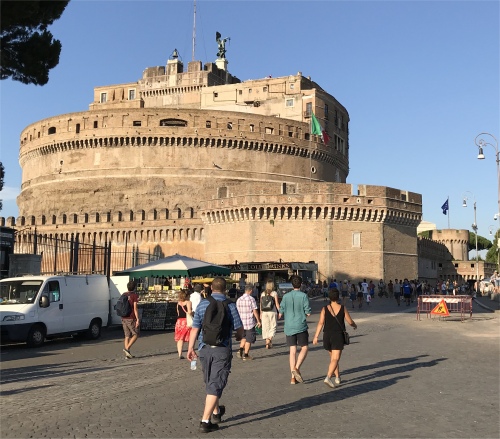 Castel Sant'Angelo |
Julius Caesar ruled for a time as dictator, and his nephew Octavian became Rome's first emperor, assuming the title Augustus. During the reign of Augustus, Christ was born, and though Christians were persecuted until the 4th century, the new religion took hold and Rome became the main centre of Christianity.
Even though it was the seat of the papacy, during the Middle Ages Rome went into decline. The city recovered spectacularly in the mid-15th century, and for over 200 years was embellished by the greatest artists of the Renaissance and the Baroque.
Finally, in 1870, Rome became the capital of the newly unified Italy.
Eventually, the train rattled to a stop in Rome Termini station. The walk along the platform to the concourse was several hundred metres; my bag was heavy. I just wanted to reach my destination with the least amount of hassle, so I took a taxi from the station. It was driven by a 29 year old lad who was keen to practice his English on me. "Italians always seem to have an American or Australian accent," he told me, "we can't quite get the hang of the proper English." "Don't worry," I replied, "I still haven't got the hang of it either."
As he weaved about the streets in central Rome, he pointed out a shop, "Tiger". "Tiger sell quirky items to adults, not toys, just interesting, quirky goods. My father used to work for them, travelling around the world seeking out fresh quirky things. Although he could have retired at 62, he kept on working until he was 66. He is now 70. I loved England when I went there, I loved London, I could live there, and the people are all friendly. I also visited Cambridge, Windsor and Stonehenge. I would like to travel more." He was an ambitious young fellow. I wished him well on his journey through life.
I was dropped off at the Crowne Plaze Rome-St. Peters hotel, just off Via Aurelia Antica, not far from Vatican City. Dan chose this hotel since it had a swimming pool and had close access to the Metro. Dan finally appeared at the hotel; it was good to see him again. We shared a couple of beers while our room was being prepared and caught up with news.
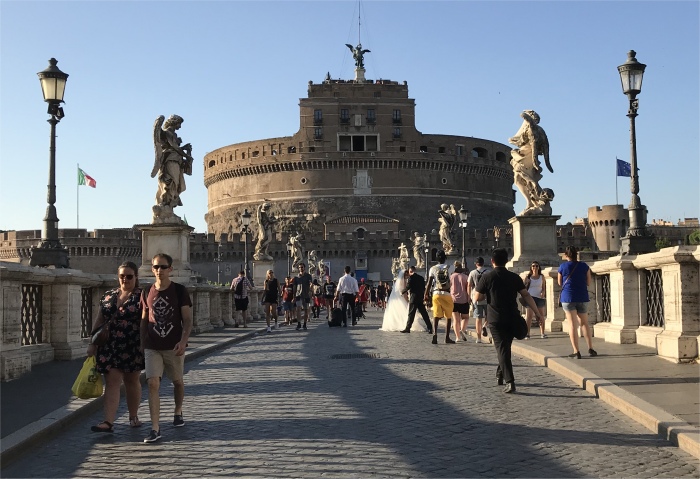 Ponte Sant'Angelo |
Known as Hadrian's Tomb, the Castel Sant'Angelo is a fortress located on the right bank of the Tiber, a short distance from the Vatican City. In the year 135AD, construction of the building began under the direction of the Emperor Hadrian, who intended to use it as mausoleum for himself and his family. It was finished in the year 139AD and a short time later, it became a military building, which in the year 403AD would be integrated to the Aurelian Walls. In the year 590AD, while a great epidemic of plague devastated the city, the Pope Gregory I had a vision of Saint Michael the Archangel on top of the castle, announcing the end of the epidemic. In memory of the apparition the building is crowned with a statue of an angel. It has also been a prison and a papal residence. In the year 1277 an 800m fortified corridor was built that connected the castle with the Vatican City so that the Pope could escape in the event that he were in danger. During the sieges that occurred in Rome during 1527, the Pope Clement VII used the fortress as a refuge.
The Castel Sant'Angelo has an atypical destiny in the historical-artistic panorama of the capital. While all the other Roman monuments are overwhelmed, reduced to ruins or quarries of bare materials to be recycled in new, modern buildings, the Castle, through an uninterrupted series of developments and transformations that seem to slip into one another, seems to have been preserved in pristine condition for almost two thousand years.
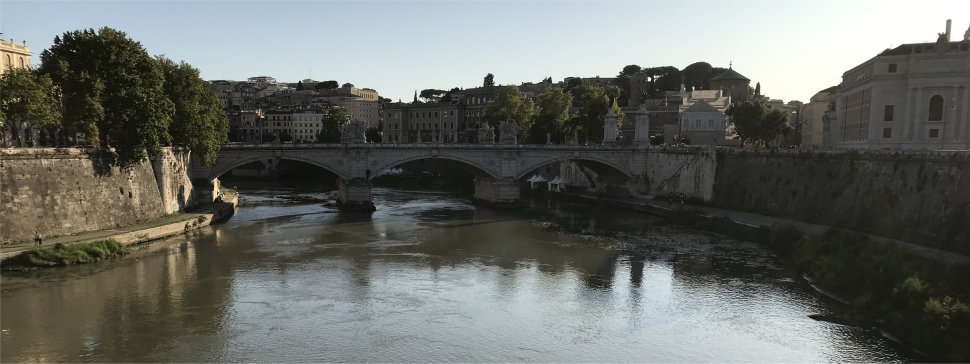 River Tiber from Ponte Sant'Angelo |
In 1669, Pope Clement IX had commissioned the making of the sculptures we can appreciate today along the bridge, by famed Baroque sculptor Gian Lorenzo Bernini, who decided to perfectly fit the statues with the bridge's name and purpose. Ten strikingly beautiful angel sculptures line the spectacular travertine marble bridge. Each sculptured angel symbolizes a part from the story of Jesus Christ's suffering and death by crucifixion. Statues of the saints Peter and Paul watch over the entrance way of the bridge.
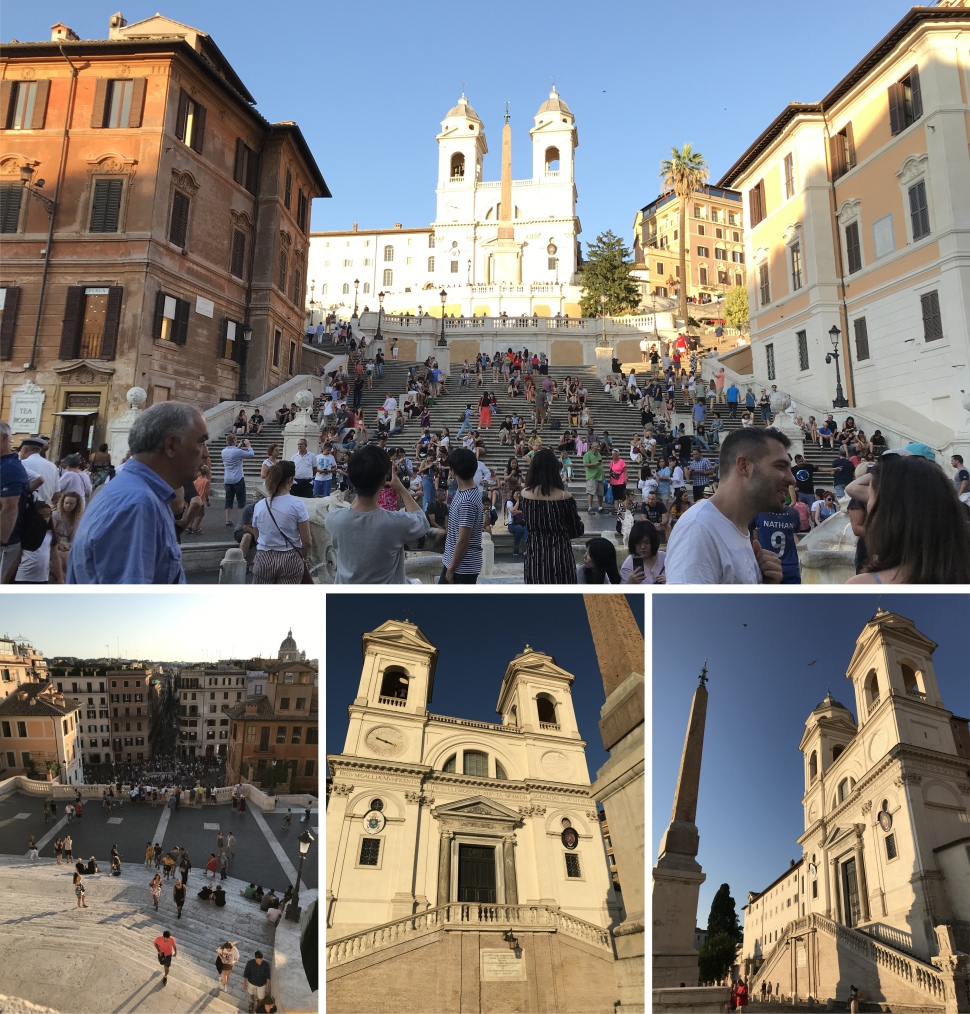 Spanish Steps and Trinita dei Monti Church |
The Spanish steps were built in 1723-1725 by a design of the rather little known architect Francesco de Sanctis and were funded by French diplomat ╔tienne Gueffier. It was built in order to link the TrinitÓ dei Monti church that was under the patronage of the king of France, with the Spanish square below. The long, triangular Spanish square is named after the Spanish Embassy to the Holy See. In the 17th century, the area around the embassy was even considered Spanish territory. The idea of connecting the church with the square below originates from the 17th century, when the French also planned a statue of King Louis XIV of France at the top of the staircase. This plan was never executed, due to the refusal of the Pope.
In the piazza at the bottom of the Spanish Steps is the 17th century Fountain of the Old Boat, "Fontana della Barcaccia", spouting water as she sinks. The story behind the ship is that the River Tiber often flooded before the city walls were built and in 1598 there was a particularly bad flooding and the Piazza di Spagna was flooded up to a metre. Once the water withdrew, a boat was left behind in the square.
In the piazza, at the corner on the right as one begins to climb the steps, is the house where English poet John Keats lived and died of consumption in 1821. It is now a museum dedicated to his memory, full of memorabilia of the English Romantic generation.
At the foot of the Spanish Steps the area is of upmarket chic, with an endless supply of small boutique designer shops and a wide range of restaurants and bars. The Via dei Condotti facing the Spanish Steps is where you want to go if you want to shop for Armani, Prada, Versace, Dolce and Gabbana or Gucci. This is not only one of the richest streets in Italy but also one of the best for shopping in Rome.
We sampled a beer in this area before homing in on a tour bus stop to catch the next bus. We knew there were still busses touring, our tickets had not expired, so we and others patiently waited, and waited, but there were no signs of tour busses.
We, and others, gave up, and caught a cab to the Colosseum. I asked the driver if he could recommend a good restaurant there, the Hostaria Al Gladiatore was his verdict. He dropped us there, and we wined and dined well, a perfect way to meet up again.
